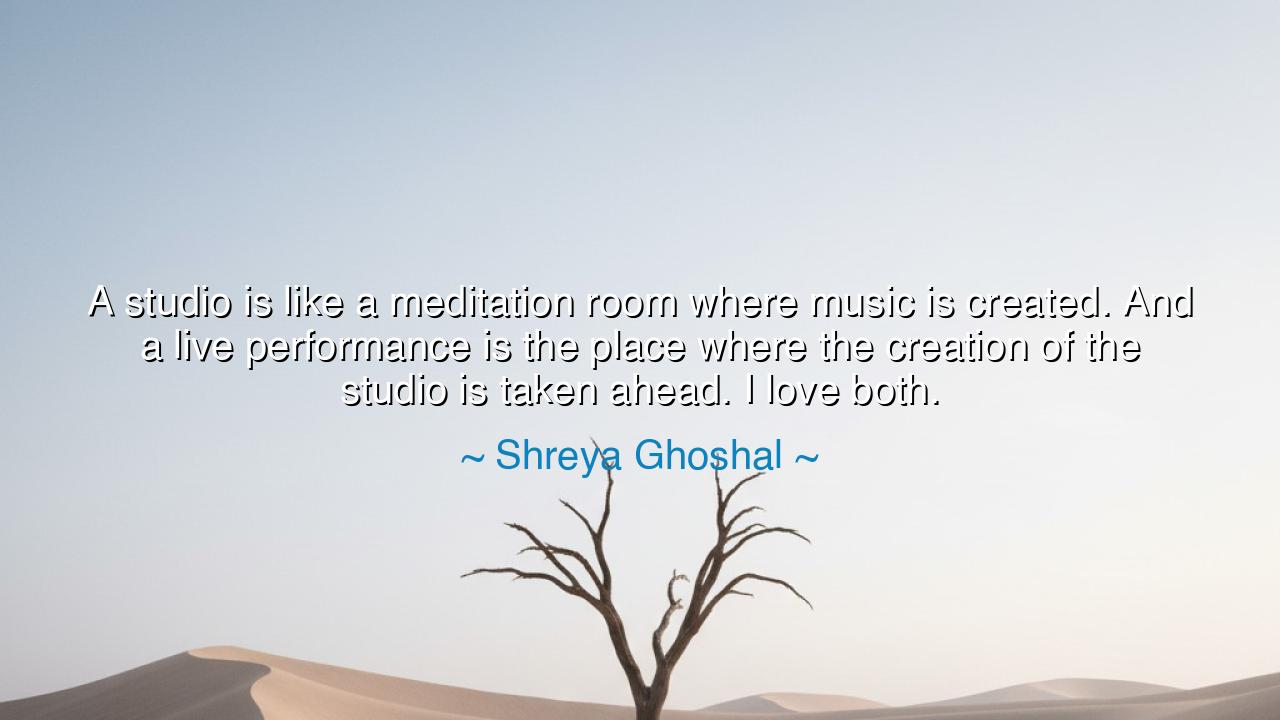
A studio is like a meditation room where music is created. And a
A studio is like a meditation room where music is created. And a live performance is the place where the creation of the studio is taken ahead. I love both.






“A studio is like a meditation room where music is created. And a live performance is the place where the creation of the studio is taken ahead. I love both.” Thus spoke Shreya Ghoshal, whose voice has carried devotion and beauty into countless hearts. In her words lies a sacred wisdom: that music has two lives, one born in silence and solitude, the other blossoming in the shared breath of community. Both are holy, both are necessary, and both together complete the journey of creation.
The ancients would have said: “Every temple has its inner sanctum and its public altar.” The studio is the inner sanctum, the meditation room where the artist communes with self, sound, and spirit. Here, ideas are fragile like newborn flame, nurtured with patience and protected from the winds of distraction. It is in this place of stillness that raw inspiration is shaped into melody, harmony, and rhythm. Without such solitude, creation cannot be born.
But creation does not end in solitude. As Ghoshal teaches, the live performance is where the work is carried forward, where the flame kindled in silence becomes a fire shared among many. It is the public altar, where hearts beat together, where voices join, and where the sacred offering of music is given life beyond the self. What began as a whisper in the studio becomes thunder in the world. Thus, both silence and sound, solitude and community, belong to the cycle of art.
Consider the story of Ludwig van Beethoven. In his small, private rooms, though deaf, he labored in silence, hearing music only within his mind. These were his meditation rooms, where he poured his soul into manuscripts. Yet when his Ninth Symphony was finally performed live, though he could not hear it, the audience erupted with such power that they had to turn him to face their applause. The solitude of his studio reached its fulfillment only in the shared rapture of performance.
Or reflect on the Bhakti singers of India, who often composed devotional songs in quiet meditation, whispering prayers into the air. Yet when those songs were sung before communities in temples, they transcended the individual, becoming waves of collective ecstasy. The private devotion of the studio met the communal devotion of performance, and together they created transformation.
The meaning of Shreya’s words is clear: creation must be both inward and outward. Without the studio, art remains unformed, unfocused, and without root. Without the performance, art remains unseen, unheard, and without fruit. True artistry lies in loving both—the silence that nurtures and the sound that liberates.
The lesson for us is profound: in all endeavors, honor both the private discipline and the public sharing. Nurture your craft in solitude, where you refine your skills like a monk in meditation. But also bring your work to the world, where it can live, grow, and inspire others. A seed kept in the dark will never nourish, and a tree without roots will never endure.
Practical counsel follows: create your own studio, a space of silence and focus where you may labor in devotion to your craft. Treat it as a meditation room, a sacred chamber. Then, when your work is ready, do not fear to carry it into the world. Share it with others, let it breathe, let it be carried beyond you. For in this cycle—solitude and community—you will find the wholeness of creation, just as Shreya Ghoshal has found in her love for both.
So remember this, O seekers of beauty: the studio is your sanctuary, the stage is your battlefield, and both are holy. In silence, you shape your truth; in sound, you set it free. Love both, and your art will endure beyond time, carrying your spirit into the hearts of generations yet unborn.






AAdministratorAdministrator
Welcome, honored guests. Please leave a comment, we will respond soon